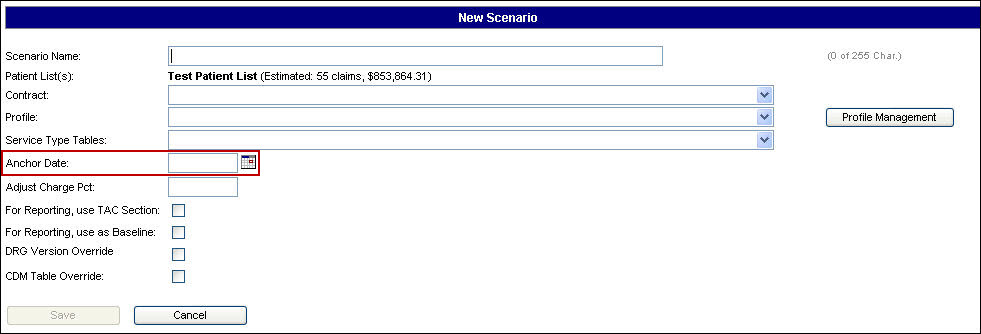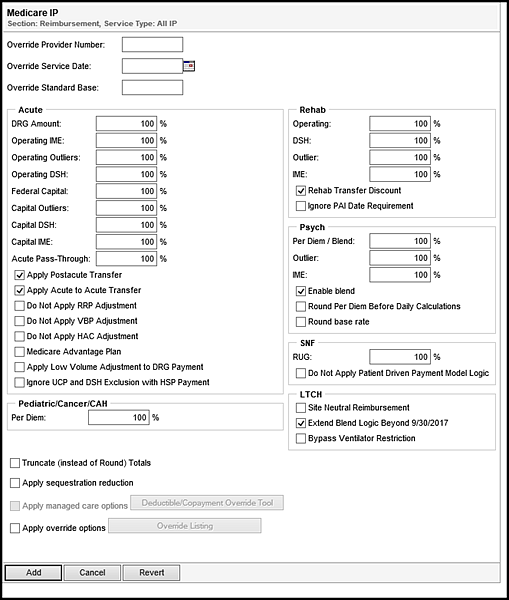Tips for Using Anchor Dates and DRG Overrides
An anchor date in your model adjusts the first date of service for all claims in a scenario so you can reprice against a given table, based on the effective date of the table.
Anchor dating is typically used for future-dated fee schedules. Changing the anchor date does not change any actual claim data. For example, the length of stay on the claim remains the same when you use an anchor date.
When using the Medicare IP reimbursement tool in your model, there are two ways to anchor date the claims:
- From the scenario setup section of the Model Document Edit page.
- From the Medicare IP reimbursement tool.
Using the scenario setup section of the Model Document Edit page is the most common method for anchor dating claims. In this section of the page, you can simply enter the anchor date you want to use for a specific scenario.
For more information about adding a scenario to a model document, refer to Add a Scenario to a Model Document.
Anchor dating within the Medicare IP reimbursement tool is a less common way to anchor date accounts, but it provides additional flexibility by allowing you to use two dates. You can specify your anchor date in the reimbursement tool for specific Medicare factors, and use a second anchor date at the scenario level that points the scenario toward other effective-dated tables in the contract profile. This method is especially useful for modeling Managed Care profiles.
In the Medicare IP reimbursement tool, you can specify your anchor date in the Override Service Date field.
Note: Using this method for anchor dating your model can affect the Wage Index and other factors.
For more information about the Medicare IP reimbursement tool, refer to Medicare IP.
|
DRG 391 |
v24 |
0.1564 |
Normal Newborn |
|
DRG 391 |
v25 |
0.9565 |
Esophagitis, Gastroent. & Misc. Disgestive Disorders w MCC |
Account Date of Service 06/01/2007
Model DRG override set to v25
|
No anchor date |
Account will price using weight 0.1564 for Normal Newborn |
|
Anchor date 09/30/2007 or prior |
Account will price using weight 0.1564 for Normal Newborn |
|
Anchor date 10/01/2007 and forward |
Account will price using weight 0.9565 for Esophagitis, Gastroent. & Misc. Disgestive Disorders w MCC |
Account Date of Service 06/01/2007
Model DRG override set to v24
|
No anchor date |
Account will price using weight 0.1564 for Normal Newborn |
|
Anchor date 09/30/2007 or prior |
Account will price using weight 0.1564 for Normal Newborn |
|
Anchor date 10/01/2007 and forward |
Account will price using weight 0.9565 for Esophagitis, Gastroent. & Misc. Disgestive Disorders w MCC |
Account Date of Service 05/01/2008
Model DRG override set to v25
|
No anchor date |
Account will price using weight 0.9565 for Esophagitis, Gastroent. & Misc. Disgestive Disorders w MCC |
|
Anchor date 09/30/2007 or prior |
Account will price using weight 0.1564 for Normal Newborn |
|
Anchor date 10/01/2007 and forward |
Account will price using weight 0.9565 for Esophagitis, Gastroent. & Misc. Disgestive Disorders w MCC |
Account Date of Service 05/01/2008
Model DRG override set to v24
|
No anchor date |
Account will price using weight 0.9565 for Esophagitis, Gastroent. & Misc. Disgestive Disorders w MCC |
|
Anchor date 09/30/2007 or prior |
Account will price using weight 0.1564 for Normal Newborn |
|
Anchor date 10/01/2007 and forward |
Account will price using weight 0.9565 for Esophagitis, Gastroent. & Misc. Disgestive Disorders w MCC |
|
DRG 014 |
v24 |
1.2118 |
Intracranial Hemorrhage or Cerebral Infarction |
|
DRG 014 |
v25 |
0 |
Invalid DRG |
Account Date of Service 06/01/2007
Model DRG override set to v25
|
No anchor date |
Account will price using weight 1.2118 for Intracranial Hemorrhage or Cerebral Infarction |
|
Anchor date 09/30/2007 or prior |
Account will price using weight 1.2118 for Intracranial Hemorrhage or Cerebral Infarction |
|
Anchor date 10/01/2007 and forward |
Account will price to 0.00 as an invalid DRG |
Account Date of Service 06/01/2007
Model DRG override set to v24
|
No anchor date |
Account will price using weight 1.2118 for Intracranial Hemorrhage or Cerebral Infarction |
|
Anchor date 09/30/2007 or prior |
Account will price using weight 1.2118 for Intracranial Hemorrhage or Cerebral Infarction |
|
Anchor date 10/01/2007 and forward |
Account will price to 0.00 as an invalid DRG |
Account Date of Service 05/01/2008
Model DRG override set to v25
|
No anchor date |
Account will price to 0.00 as an invalid DRG |
|
Anchor date 09/30/2007 or prior |
Account will price using weight 1.2118 for Intracranial Hemorrhage or Cerebral Infarction |
|
Anchor date 10/01/2007 and forward |
Account will price to 0.00 as an invalid DRG |
Account Date of Service 05/01/2008
Model DRG override set to v24
|
No anchor date |
account will price to 0.00 as an invalid DRG |
|
Anchor date 09/30/2007 or prior |
account will price using weight 1.2118 for Intracranial Hemorrhage or Cerebral Infarction |
|
Anchor date 10/01/2007 and forward |
account will price to 0.00 as an invalid DRG |
If you are running a model thatis not using the Medicare IP reimbursement tool, with a DRG override, the anchor date will not affect the DRG grouping or pricing. You should anchor date to match your service type and lookup table effective dates, including any DRG weight tables.
If you are running a model that is using the Medicare IP reimbursement tool, with a DRG override, the anchor date will affect the DRG grouping and pricing. You will need to anchor date to match your DRG version chosen.
Note: This can become complicated if you have future effective dated service type and/or lookup tables referenced in your profile. The anchor date you choose in the scenario will point to specific versions of those tables. In this case, you can use the anchor option in the Medicare IP node as well as the anchor date option in the scenario.

